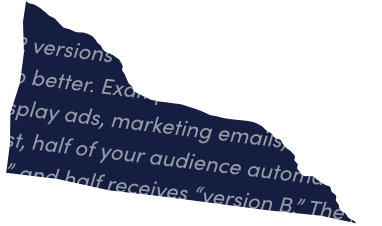Conversion rate, or CVR, is a common metric used in digital marketing to denote the percentage of website visitors who ‘convert’ by taking a desired action, such as making a purchase, filling out an online form, or subscribing to a newsletter. CVR is a key indicator of how effectively a website is converting visitors into customers or leads.
What is CVR?
Conversion rate, also known as CVR, is a marketing metric that tells you how many users are converting on your website. A conversion is when a user performs a pre-defined action (or call to action) on your website or other online asset. This could be anything from creating an account to purchasing a product or requesting a demo. CVR is expressed as a percentage; the higher the percentage, the better your conversion rate.
How to measure CVR
Measuring your CVR is quite simple. Just look at how many people completed the call to action (converted) on a web page or content piece, and divide that number by the total number of views.
For example, say 1,000 people read a promotional email you send out with a link to sign up, and 100 of those readers follow through by signing up. Your conversion rate would be 100 divided by 1,000 or 10%.
You can also think of it this way:
Conversions / Views = Conversion Rate
Why is CVR important?
Conversion rate is very important to determine whether your web page, email campaign or marketing content is effective. CVR lets you know if your content is resonating with your audience and how many people are persuaded to follow your call to action.
Looking just at the number of people who converted lacks meaningful context. For example, if 250 people subscribed to your service, that might seem great. However, if 250,000 people visited your website, and therefore, your conversion rate is only 0.1%, you’ll know it’s time to rethink your marketing strategy. Obviously, you want your content to be seen by a large number of potential customers, but all the eyes in the world won’t matter if your conversion rate is too low.
CVR vs CTR
Conversion rate is far from the only factor you can use to measure your content’s success. Many businesses look at CVR and click-through rate (CTR) in tandem. CTR is a measure of how many users clicked on a link. You can have a high CTR but a low CVR, because CTR only looks at whether they clicked on a link, and does not indicate whether they converted.
Let’s say you’re selling a subscription to a magazine on your website. If you have a high CTR and low CVR, that means people are interested in what you’re offering but aren’t sealing the deal and subscribing. If you have a low CTR and high CVR, that means not very many people are heading to the offers page, but most of them are ready to subscribe once there.
What is a good CVR?
Across all industries, a typical CVR falls between 2-5%. Typically, businesses advertising large-scale or niche products, like industrial equipment, have higher CVRs since the number of people in the market for those products is fairly low, and they’re more likely to convert. It may be that only 100 customers go looking for your content, but 10 of them convert, which is a 10% conversion rate.
On the other hand, businesses offering products and services that are broadly appealing are more likely to have lower CVRs since the number of potential customers is much higher. Even if 1,000 people look at your website and 50 convert, your CVR is 5%.
Price is also a factor. Luxury services or products may show a lower CVR because customers need more convincing to agree to high prices. Purchasing a $25,000 car, for example, is a much bigger decision than buying a pair of $80 boots. Therefore, a website selling boots would likely see a higher CVR than one selling cars.
Below are some examples of average CVRs by industry:
- B2C e-commerce 2%
- Industrial 5.6%
- Automotive 2%
- Cosmetic/Dental 2.3%
- Real Estate 1.7%
- Travel 4.7%
How to optimize CVR
If your conversion rate is below the average, there’s no need to panic. CVR is a measurement intended to give you valuable information and help your content perform better. Now that you know where you need to improve, you can get started optimizing with one or more of the tactics listed below.
- A/B testing: Let’s say your email campaign isn’t performing as well as you’d like. One of the easiest ways to figure out what’s going wrong is called A/B Testing. You create two versions of your email, an A and a B version, sending them out to an equal number of people. By measuring their respective CVRs, you can see which version is more appealing to your customers.
- Jazz up your calls to action: Your call to action is one of the most important parts of your content. It needs to grab your audience’s attention and be simple enough to understand at a glance. Words like join, buy, and other punchy verbs are relatively common. Many companies also add words like now or today to their calls of action to prompt the user to follow through immediately.
- Stress the benefits, but be clear: Your content likely addresses whatever problems or pain points your product seeks to solve, but it’s crucial to clarify what your product is/does. Just listing potential problems and saying your product is the solution isn’t enough; people want to know exactly what they’re buying. By clarifying beforehand, you’re more likely to avoid people clicking through who aren’t interested in buying what you’re selling.
- Attach glowing reviews: Nowadays, the internet allows anyone to advertise their business to potential customers. Savvy users have become wary of email campaigns and marketing content in general. By adding positive testimonials, you provide concrete proof that your service helped real people, and potential customers can trust your company.
- Don’t make your audience play hide and seek: There’s nothing worse than enjoying a blog’s content, wanting more, and needing to scroll around the page searching for the newsletter subscription button. Many internet users simply don’t have the time or patience to go hunting for your call to action. Put the button or link near the top where everyone can see it without needing to scroll down.
- Avoid numerous form fields: If your goal is to get people to sign up for something, you only need a little bit of basic information. Asking for an email address or credit card is very different from prying into personal or demographic information. Not only can it make some potential customers uncomfortable to answer, but it also takes longer. You risk having people start filling it out, get bored or tired of answering, and leave without completing the signup.
- Add incentives: The types of incentives will depend on your audience and what your company provides. Incentives can be coupons, promotional offerings, free downloads, or a free trial of your service. This is especially powerful if you make a limited-time offer so that users will need to act quickly to receive the incentive.
CVR examples
A Hedonist’s Guide To (Hg2) is a travel guide publisher that wanted to target new digitally-minded users with its iPhone app. The company worked with Outbrain to increase its conversion rate by raising awareness and app downloads. By integrating dynamic calls to action with Outbrain’s strategy of recommending the app to people who were on iPhones, Hg2 saw a 17% conversion rate.
Another example of improving CVR is that of CloudSponge. CloudSponge is a SaaS business offering automation services to small businesses. The company had an older and more challenging website that users found difficult to navigate. CloudSponge decided that the ideal solution would be to revamp the webpage so that users would find it easier and more convenient. By redesigning the outdated web pages, the company increased the website CVR by 33%.


